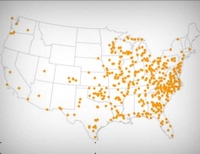- Sections
- Introduction
- Section 1: Getting started
- Section 2: Accessing Census data
- Section 3: Calculating the impact on districts
- Section 4: Repairing your democracy, now and in the future
- Tools
- Correctional Facility Locator (2020)
- Correctional Facility Locator (2010)
- Correctional Facility Locator (2000)
- Vote dilution calculator
- 2020 Worksheet [DOC] a single worksheet updated for use after the 2020 Census to determine if a county included or excluded the incarcerated population.
- Worksheets [DOC] with all of the tables used in this toolkit
- Appendices
- Handling lettered blocks
- Determining whether prisoners were included or excluded from districts with known populations.
- District population deviations & split prisons
- Weighted Voting
Appendix:
Determining whether prisoners were included or excluded from districts with known populations
If you do not know whether prisoners were included in the county legislative districts but you can get or calculate the Census population for each district, you can deduce whether prisoners are included in each district.
These two counties in Oklahoma are a clear example. We calculated the Census population by a long process not documented here. (If you are lucky your districts are simple shapes like towns and this won't be hard. Explaining how to access census data at the block level is beyond the scope of this guide.) The Incarcerated population is from the locator and the population not incarcerated was produced by subtracting the incarcerated population from the census population.
Greer County, Oklahoma
County population: 6,061
Ideal district size (county census population divided by number of districts): 2,020
Ideal district size without the prison population (population not incarcerated divided by the number of districts): 1,716
| District | Census population | Incarcerated population | Population not incarcerated |
|---|---|---|---|
| 1 | 1,777 | 72 | 1,705 |
| 2 | 2,553 | 841 | 1,712 |
| 3 | 1,731 | 0 | 1,731 |
Osage County, Oklahoma
County population: 44,437
Ideal district size (county census population divided by number of districts): 14,812
Ideal district size without the prison population (population not incarcerated divided by the number of districts): 14,376
| District | Census population | Incarcerated population | Population not incarcerated |
|---|---|---|---|
| 1 | 14,494 | 1,310 | 13,184 |
| 2 | 14,825 | 0 | 14,825 |
| 3 | 15,118 | 0 | 15,118 |
In Greer County, the Census populations for District 2 is much larger than for the other districts, but if the prisoners are subtracted, then the population totals are almost exactly equal. This suggests that the county drew the district lines without the prison population. They ignored the prison population, and drew each legislative district to be about 1/3rd of the non-incarcerated population.
In Osage County, however, the census populations are all close to the ideal district size of 14,812. If the prisoners were removed, the districts would be more unequal than they are now. This suggests that the legislature used Census data with the prisoners included when drawing the legislative districts, and ended up diluting the votes of residents in the districts without the prisons.
Events
- April 15-17, 2025:
Sarah Staudt, our Director of Policy and Advocacy, will be attending the MacArthur Safety and Justice Challenge Network Meeting from April 15-17 in Chicago. Drop her a line if you’d like to meet up!
Not near you?
Invite us to your city, college or organization.



